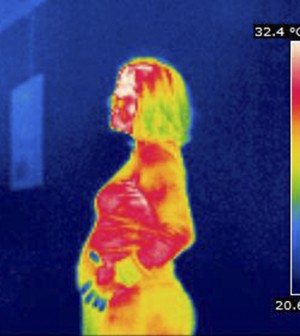- Finding Unshakable Power in a World That Wants to Pull Us ApartPosted 5 months ago
- What could a Donald Trump presidency mean for abortion rights?Posted 5 months ago
- Financial Empowerment: The Game-Changer for Women in Relationships and BeyondPosted 6 months ago
- Mental Health and Wellbeing Tips During and After PregnancyPosted 6 months ago
- Fall Renewal: Step outside your Comfort Zone & Experience Vibrant ChangePosted 7 months ago
- Women Entrepreneurs Need Support SystemsPosted 7 months ago
Thermography Versus Mammograms

Christiane Northrup, MD
Excerpted with permission from Women’s Bodies, Women’s Wisdom
Thermography—a noninvasive, safe technology that simply records the amount of heat emanating from breast (or other) tissue—is my screening modality of choice. The FDA approved it as an adjunctive breast cancer screening test in 1982, and in my view it could replace the vast number of mammograms women are subjected to.
When you get a thermogram, the thermographer uses an infrared thermal-imaging camera to capture the amount of heat on the body’s surface. Abnormal heat patterns in breast tissue indicate increased blood circulation to a given area secondary to cellular inflammation, a well-documented precursor for cancer. Thermogram images are scored according to how much inflammation is present.
If the image is highly abnormal and there is a high suspicion of cancer, then a mammogram can be ordered to confirm the diagnosis. Standard treatment would follow. In the vast majority of cases, however, a thermogram will indicate a tendency toward breast abnormalities long before these would develop into palpable lumps or mammographic abnormalities.[1]
This is good news because it means a thermogram allows a woman and her health care practitioner to be proactive. If her scan shows inflammation, she can then go on a program to improve her breast health. Decreased cellular inflammation can easily be documented on a follow-up thermogram. This approach is far more empowering than that of routine mammography, in which a woman simply waits for an abnormality to show up without being given the tools to be proactive about her breast health.
A thermogram can help a woman diagnosed with ductal carcinoma in situ (and her health care providers) decide whether or not she requires aggressive or conservative treatment. Another valuable bonus is that thermograms don’t confuse harmless fibrocystic masses with worrisome lumps as often as mammography.[2]
Routine thermograms could save thousands of women from undergoing unnecessary biopsies and disfigurement. And because breast inflammation is a marker of inflammation in other areas of the body, using thermograms would also help improve overall health at the same time. Unfortunately thermography is often not covered by insurance (scans cost anywhere from $90 to $250), a fact that has more to do with politics and economics than science.
Thermography is the missing link that holds the key to true prevention of breast cancer, not just early detection—although it also does that very well. It allows a woman and her health care provider to determine the state of her breast health immediately, and then take steps to improve it long before a more serious condition develops.
To find a practitioner in your area who does thermography, visit www.breastthermography.com, www.breastthermography.org, or the websites for the International Academy of Clinical Thermology, www.iact-org.org, or for the American College of Clinical Thermology, www.thermologyonline.org.
Footnotes:
1. J. D. Bronzino, ed., Medical Devices and Systems (The Biomedical Engineering Handbook) (Boca Raton: CRC Press/Taylor & Francis Group, 2006).
2. N. Arora et al., “Effectiveness of a Noninvasive Digital Infrared Thermal Imaging System in the Detection of Breast Cancer,” American Journal of Surgery, vol. 196, no. 4 (October 2008), pp. 523–26.
This information is not intended to treat, diagnose, cure, or prevent any disease. All material in this article is provided for educational purposes only. Always seek the advice of your physician or other qualified health care provider with any questions you have regarding a medical condition, and before undertaking any diet, exercise, or other health program.
© Christiane Northrup, Inc. All rights reserved. Excerpted with permission from Women’s Bodies, Women’s Wisdom. Reproduction in whole or in part without permission is prohibited.
 Christiane Northrup, M.D., is a visionary pioneer and leading authority in the field of women’s health and wellness. Recognizing the unity of body, mind, and spirit, she empowers women to trust their inner wisdom, their connection with Source, and their ability to truly flourish. A board-certified ob-gyn physician, she is the author of three New York Times best selling books, Women’s Bodies, Women’s Wisdom, The Wisdom of Menopause, and her newest book, Goddesses Never Age: The Secret Prescription for Radiance, Vitality, and Wellbeing. Follow her on Facebook, Twitter, and at her Web site www.drnorthrup.com.
Christiane Northrup, M.D., is a visionary pioneer and leading authority in the field of women’s health and wellness. Recognizing the unity of body, mind, and spirit, she empowers women to trust their inner wisdom, their connection with Source, and their ability to truly flourish. A board-certified ob-gyn physician, she is the author of three New York Times best selling books, Women’s Bodies, Women’s Wisdom, The Wisdom of Menopause, and her newest book, Goddesses Never Age: The Secret Prescription for Radiance, Vitality, and Wellbeing. Follow her on Facebook, Twitter, and at her Web site www.drnorthrup.com.






